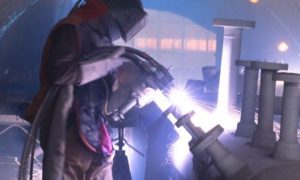Technology of manufacturing, retrofit and overhaul of shell and tube heat exchangers
Tube disassembly technology
Regardless of which joint type is used between the tube and the tubesheet, the first step is to remove the tube from the joint.
This is always carried out with dedicated pressing tongs inserted into the bore of the tube, controlled and moved by a multi-piston hydraulic actuator with an axial force of 6–32 tons.
This technique allows the tubesheet to be reworked multiple times without the risk of damaging the holes.
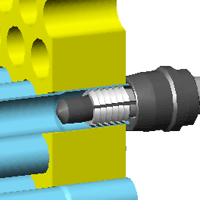
Complementary operations
All plugs covering the damaged tubes must be removed before the tubes are removed.
This is done by disassembly or reaming.
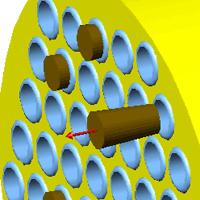
Any solid deposits (scale, corrosion) are removed from the holes using special drills.
This operation is necessary so that subsequent precision specialty tools can be effectively used.
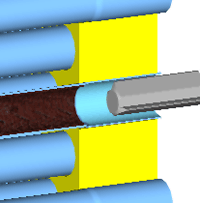
In exchangers where the tubes are additionally welded to the tubesheet, the welds are removed with dedicated milling heads before the tubes are removed.
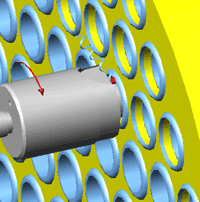
During dismantling thin-walled tubes, they are cut downstream from the tubesheet with a dedicated tool.
This is necessary when there are multiple baffles inside the exchanger.
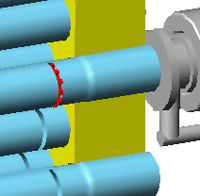
In most cases, the tube is manually removed from the bundle after breaking.
In some exchangers, the outer surfaces of the tubes are covered with solid deposits or the tubes are deformed. In such cases, it is necessary to use high axial force (a special actuator) to remove the tube from the bundle.
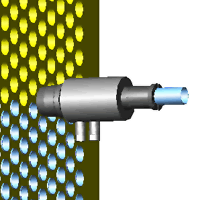
Tube installation technology
The flared joint technique is almost the same as riveting, and in both cases the joint is obtained through plastic forming.
However, while riveted joints are now obsolete, a flared joint between a tube and a tubesheet is invaluable.
For a typical rigid tubesheet/soft tube configuration, a self-feed flaring tool connected to an electronically torque-controlled drive is commonly used to maintain the same flaring length, tube thickness and ligament thickness in all tubes.
In currently manufactured shell and tube heat exchangers, about 80% of the joints are flared joints.
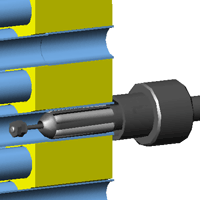
Complementary operations
For a tight and durable tube-to-tubesheet joint, the adjoining surfaces of the hole and the tube must be smooth and clean.
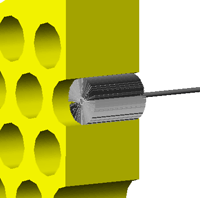
Tubes are inserted by pilots to eliminate the risk of being blocked on baffles and getting damaged.
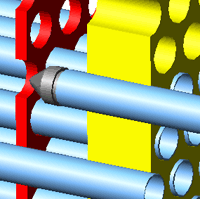
By immobilizing the tube and eliminating the play between the tube and the tubesheet hole, the tube is prevented from moving and rotating during flaring.
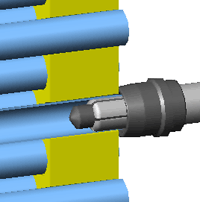
Tube processing excess is removed using a fly cutter.
In addition, the tubes can be flared or rounded.

Special tube-to-tubesheet joints
During the production of exchangers for the highest working parameters, small grooves are often used in the tubesheet holes, which act as labyrinth seals after flaring. The use of these grooves, however, makes it necessary to increase the length of the flaring itself, which in such cases is performed in one or two stages, depending on the length. The rapid development of welding technology has provided the means to produce precise and reliable welded tube-to-tubesheet joints. Even better results are currently obtained by combining typical flaring techniques with welding techniques: flaring + welding, clinching + welding, or for exchangers with the highest operating parameters: grooves in the hole + clinching + flaring + welding. In addition to regular tube flaring and hydraulic expansion, we also offer a combination of both techniques with orbital welding of tubes and tubesheets using Polysoude automatic welding machines.
Current turbine condenser designs, which are a compromise between efficiency, reliability and cost, are a major challenge for tube fitting contractors.
A relatively hard, thin-walled (0.3–0.5 mm) seamed tube must be flared in a soft, flaccid, stainless steel tubesheet.
The use of straight flaring tools with an integral feed unit produces high precision flared joints with a repetitive flaring rate of ± 1%.
This effect is obtained after testing on a test plate and setting the optimum torque for the flaring tool drive.
This protects the ligaments from damage.
Such an effect is not possible when using a self-feed flaring tool.

Increasingly higher operating parameters of exchangers, especially in the energy sector, the chemical industry and disposal equipment, force the use of very thick tubesheets.
Hydraulic expansion – the only existing technique that guarantees tight adhesion of the tube wall to the surface of the tubesheet hole.
The process is carried out slowly, with full control by a measuring and control system.
While a mechanical flaring tool would undoubtedly lead to structural changes, the most significant effect of this process is the preservation of the tubing structure in an unaltered state.
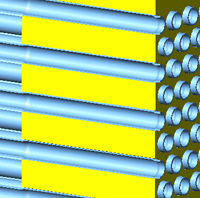
The rapid development of welding technology has provided the means to produce precise and reliable welded tube-to-tubesheet joints.
Even better results are currently obtained by combining typical flaring techniques with welding techniques:
flaring + welding, clinching + welding, or for exchangers with the highest operating parameters: grooves in the hole + clinching + flaring + welding.
In addition to regular tube flaring and hydraulic expansion, we also offer a combination of both techniques with orbital welding of tubes and tubesheets using Polysoude automatic welding machines.
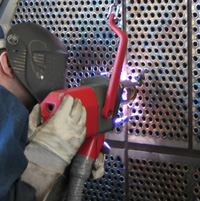
Other techniques of connecting tubes with tubesheets, such as soldering, glueing or glands are rather rare and used only outside of pressure objects.
Complementary technologies for emergency overhaul and retrofit
If there are only a few locations (up to 8%) showing ligament damage in tubesheets caused by excessive corrosion, it makes economic sense to restore them.
Such damage is often found on the tubesheets of turbine condensers on the cooling water outlet side.

During exchanger retrofits (e.g. enlarging the tube diameter at the edge of the bundle to eliminate tube vibrations), hole diameters are often enlarged.
The operation is performed with a special tool with calibration blades.
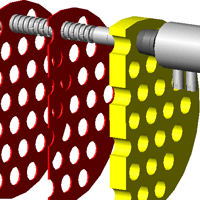
Technologies used in the manufacture and overhaul of equipment under production conditions
Precise cutting of exchanger elements from large-format metal sheets up to 180 mm thick is performed using a CNC water jet cutting machine with a working surface of 4000 x 4000 mm.
We also use a CNC plasma cutter with a working surface of 2000 x 4000 mm and a cutting thickness of up to 25 mm for acid-resistant steel sheets.
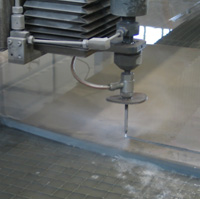
Exchanger tubesheets are usually made of homogeneous sheet metal or a large-size forging.
Such tubesheets are turned on a rotary lathe with a turning diameter of up to 3200 mm.
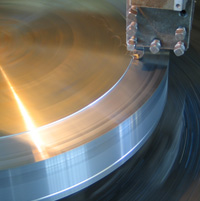
Tubesheets up to 500 mm thick are used in exchangers with the highest operating parameters.
Holes for such thicknesses are drilled
with gun drills, for example.
Drilling operations up to 360 mm are performed on a CNC machining center.
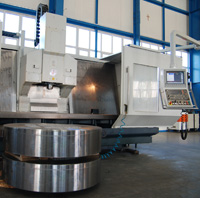
The exchanger shells are made of sheet metal
rolled using NC rollers.
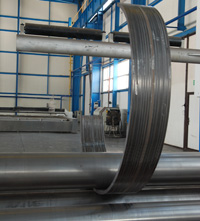
To ensure high quality of welded joints, we use an NC submerged arc welding (SAW) machine.
Weld thickness up to 100 mm.
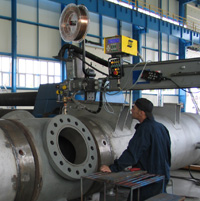
Bent tubes, otherwise known as U-tubes, are used
in U-tube exchangers.
We use a pipe bender to prefabricate such U-tubes of any radius and length.
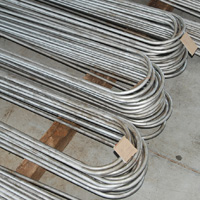
Cleaning metal surfaces from rust, varnish and paint residues before applying anti-corrosion coatings requires blast cleaning in a shot blasting chamber.
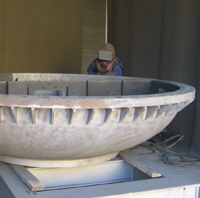
To ensure longer life of exchangers, anti-corrosion coatings are applied to steel surfaces.
Coatings are applied in a spray booth to ensure that the correct parameters of the anti-corrosion coating are achieved through:
- Traditional application of varnish and paint coatings
- Electrostatic coating.
Our portfolio also includes metalization of tubesheets by arc spraying.
